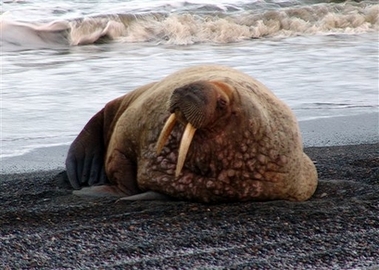
|
|
A walrus
|
Thousands of walrus have appeared on Alaska's northwest coast in what conservationists are calling a dramatic consequence of global warming melting the Arctic sea ice.
Alaska's walrus, especially breeding females, in summer and fall are usually found on the Arctic ice pack. But the lowest summer ice cap on record put sea ice far north of the outer continental shelf, the shallow, life-rich shelf of ocean bottom in the Bering and Chukchi seas.
Walrus feed on clams, snails and other bottom dwellers. Given the choice between an ice platform over water beyond their 630-foot diving range or gathering spots on shore, thousands of walrus picked Alaska's rocky beaches.
"It looks to me like animals are shifting their distribution to find prey," said Tim Ragen, executive director of the federal Marine Mammal Commission. "The big question is whether they will be able to find sufficient prey in areas where they are looking."
According to the National Snow and Ice Data Center at the University of Colorado at Boulder, September sea ice was 39 percent below the long-term average from 1979 to 2000. Sea ice cover is in a downward spiral and may have passed the point of no return, with a possible ice-free Arctic Ocean by summer 2030, senior scientist Mark Serreze said.
Starting in July, several thousand walrus abandoned the ice pack for gathering spots known as haulouts between Barrow and Cape Lisburne, a 300-mile stretch of Alaska coastline.
The immediate concern of new, massive walrus groups for the U.S. Fish and Wildlife Service is danger to the animals from stampedes. Panic caused by a low-flying airplane, a boat or an approaching polar bear can send a herd rushing to the sea. Young animals can be crushed by adults weighing 2,000 pounds or more.
Longer term, biologists fear walrus will suffer nutritional stress if they are concentrated on shoreline rather than spread over thousands of miles of sea ice.
Walrus need either ice or land to rest. Unlike seals, they cannot swim indefinitely and must pause after foraging.
点击查看更多双语新闻
(Agencies)
|
近日,几千头海象出现在美国阿拉斯加西北海岸。环境保护主义者认为,这是全球变暖导致北极海冰融化而造成的一个严重后果。
阿拉斯加地区的海象——尤其是正处于繁殖期的雌海象,在夏秋季节通常活跃在北极的大片浮冰上。但今年夏天北极冰帽面积缩小至历史最低记录,使海冰推移至白令海和楚科奇海一带底栖生物丰富的浅大陆架外围的远北地区。
海象以蛤蜊、蜗牛和其他海底生物为食。由于冰面下海水深度超过了海象的下潜深度630英尺,数千只海象不得不迁移至阿拉斯加的岩石海滩上。
美国联邦海洋哺乳动物委员会执行理事蒂姆•里甘说,“在我看来,海象们迁移是为了觅食。最重要的问题在于它们能否在新的迁移地觅得充足的食物。”
据美国科罗拉多大学博尔德分校国家冰雪数据研究中心的统计资料显示,今年9月的北极海冰面积比1979年至2000年的平均值低39%。资深科学家马克•塞雷利兹说,北极海冰面积呈螺旋式下降而且可能已经超过极限点。到2030年夏季,北冰洋的海冰可能将全部融化。
从今年7月开始,数千头海象离开它们原先栖息的浮冰带,迁移至位于巴罗和利斯本角之间绵延300英里的阿拉斯加海岸线的延伸地带聚居。
美国鱼类和野生动物管理局担心集体大迁移的海象会发生踩踏的危险。低空飞过的飞机、巡游的轮船或在附近出没的北极熊都会使海象受到惊吓而冲进海里,幼象可能会被重达2000多磅的成年象压伤甚至压死。
生物学家指出,从长远来看,如果海象聚居在海岸上,而非分散地生活在海冰上,它们将面临觅食压力。
海象的主要休息地为冰面或陆地。与海豹不同,海象不能随时游泳,它们在捕食后必须稍作休息。
(英语点津姗姗编辑)
|